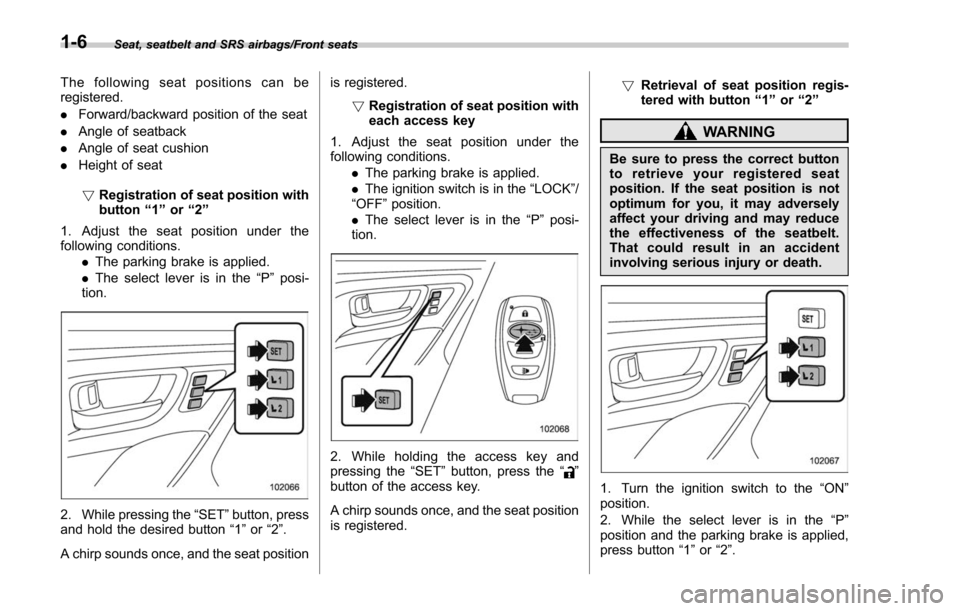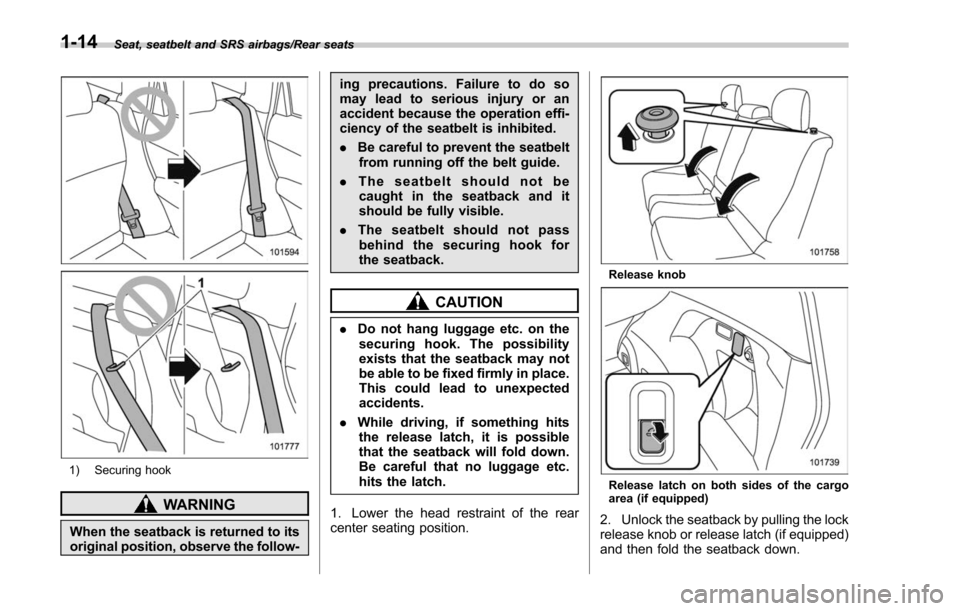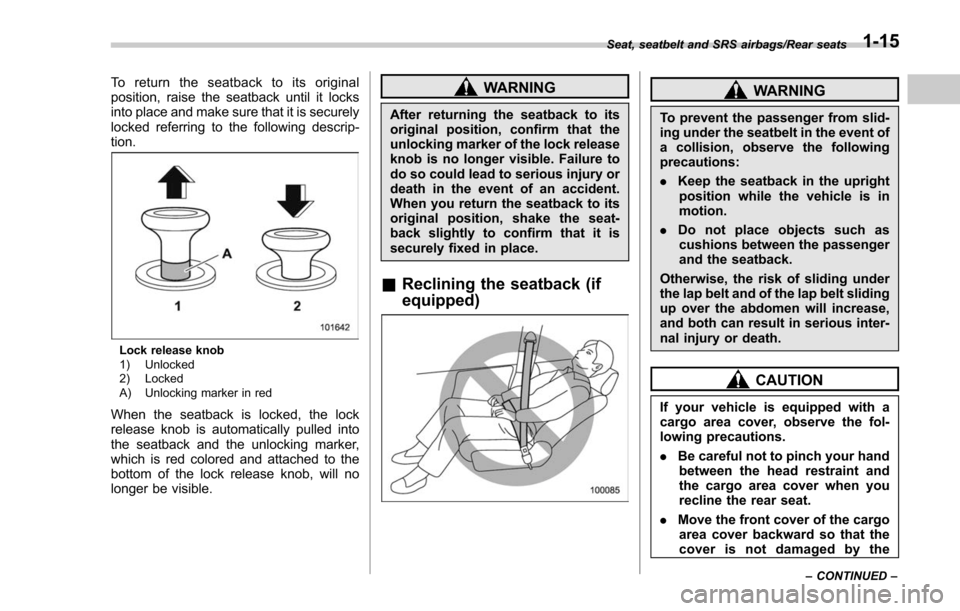2017 SUBARU FORESTER warning
[x] Cancel search: warningPage 37 of 634

Seat, seatbelt and SRS airbags/Front seats
The following seat positions can be
registered.
.Forward/backward position of the seat
. Angle of seatback
. Angle of seat cushion
. Height of seat
! Registration of seat position with
button “1 ” or “2”
1. Adjust the seat position under the
following conditions. .The parking brake is applied.
. The select lever is in the “P”posi-
tion.
2. While pressing the “SET”button, press
and hold the desired button “1”or “2”.
A chirp sounds once, and the seat position is registered.
!Registration of seat position with
each access key
1. Adjust the seat position under the
following conditions. .The parking brake is applied.
. The ignition switch is in the “LOCK”/
“OFF ”position.
. The select lever is in the “P ” posi-
tion.
2. While holding the access key and
pressing the “SET”button, press the “”
button of the access key.
A chirp sounds once, and the seat position
is registered. !
Retrieval of seat position regis-
tered with button “1 ” or “2 ”
WARNING
Be sure to press the correct button
to retrieve your registered seat
position. If the seat position is not
optimum for you, it may adversely
affect your driving and may reduce
the effectiveness of the seatbelt.
That could result in an accident
involving serious injury or death.
1. Turn the ignition switch to the “ON”
position.
2. While the select lever is in the “P ”
position and the parking brake is applied,
press button “1”or “2”.
1-6
Page 39 of 634

Seat, seatbelt and SRS airbags/Front seats
&Head restraint adjustment
WARNING
. Never drive the vehicle with the
head restraints removed because
they are designed to reduce the
risk of serious neck injury in the
event that the vehicle is struck
from the rear. Also, never install
the head restraints the opposite
way round. Doing so will prevent
the head restraints from func-
tioning as intended. Therefore,
when you remove the head re-
straints, you must reinstall all
head restraints correctly to pro-
tect vehicle occupants.
. All occupants, including the dri-
ver, should not operate a vehicle
or sit in a vehicle ’s seat until the
head restraints are placed in their
proper positions in order to mini-
mize the risk of neck injury in the
event of a crash.
Both the driver ’s seat and front passen-
ger ’s seat are equipped with head re-
straints. Both head restraints are adjusta-
ble in the following ways. !
Head restraint height adjustment
1) Head restraint
2) Release button
To raise:
Pull the head restraint up.
To lower:
Push the head restraint down while
pressing the release button on the top of
the seatback.
To remove:
While pressing the release button, pull out
the head restraint.
To install:
Install the head restraint into the holes that
are located on the top of the seatback until
the head restraint locks. Press and hold
the release button to lower the head
restraint.
Each head restraint should be adjusted so
that the center of the head restraint is
closest to the top of the occupant ’s ears.
NOTE
When the head restraint cannot be
pulled out or installed due to insuffi-
cient clearance between the head re-
straint and the roof, tilt the seat and
then perform the installation and re-
moval tasks.
1-8
Page 42 of 634

Rear seats
WARNING
Seatbelts provide maximum re-
straint when the occupant sits well
back and upright in the seat. Do not
put cushions or any other materials
between occupants and seatbacks
or seat cushions. If you do so, the
risk of sliding under the lap belt and
of the lap belt sliding up over the
abdomen will increase, and both can
result in serious internal injury or
death.
WARNING
Never stack luggage or other cargo
higher than the top of the seatback
because it could tumble forward and
injure passengers in the event of a
sudden stop or accident.
&Armrest (if equipped)
To lower the armrest, pull on the top edge
of the armrest.
WARNING
To avoid serious injury, passengers
must never be allowed to sit on the
center armrest.
Seat, seatbelt and SRS airbags/Rear seats
–CONTINUED –1-11
Page 43 of 634

Seat, seatbelt and SRS airbags/Rear seats
&Head restraint adjustment
Both the rear window side seats and the
rear center seat are equipped with head
restraints.
WARNING
. Never drive the vehicle with the
head restraints removed because
they are designed to reduce the
risk of serious neck injury in the
event that the vehicle is struck
from the rear. Therefore, when
you have removed the head re-
straints, you must reinstall all
head restraints to protect vehicle
occupants.
. All occupants, including the dri-
ver, should not operate a vehicle
or sit in a vehicle ’s seat until the
head restraints are placed in their
proper positions in order to mini-
mize the risk of neck injury in the
event of a crash. !
Rear windows side seating position
1) Head restraint
2) Release button
To remove:
While pressing the release button, pull out
the head restraint.
To install:
Install the head restraint into the holes that
are located on the top of the seatback until
the head restraint locks. Press and hold
the release button to lower the head
restraint.
After installing the head restraint, make
sure it is securely locked. !
Rear center seating position
CAUTION
The head restraint is not intended to
be used at the lowest position.
Before sitting on the seat, raise the
head restraint to the extended posi-
tion.
1) When not used (retracted position)
2) When used (extended position)
1-12
Page 44 of 634

1) Head restraint
2) Release button
To raise:
Pull the head restraint up.
To lower:
Push the head restraint down while
pressing the release button on the top of
the seatback.
To remove:
While pressing the release button, pull out
the head restraint.
To install:
Install the head restraint into the holes that
are located on the top of the seatback until
the head restraint locks. Press and hold
the release button to lower the head
restraint.When the rear-center seating position is
occupied, raise the head restraint to the
extended position. When the rear center
seating position is not occupied, lower the
head restraint to improve rearward visibi-
lity.
&
Folding down the rear seat-
back
WARNING
. When you fold down the seat-
back, check that there are no
passengers or objects on the
rear seat. Not doing so creates
a risk of injury or property da-
mage if the seatback suddenly
folds down.
. Never allow passengers to ride
on the folded rear seatback or in
the cargo area. Doing so may
result in serious injury or death.
. Secure all objects and especially
long items properly to prevent
them from being thrown around
inside the vehicle and causing
serious injury during a sudden
stop, a sudden steering maneu-
ver or a rapid acceleration.
. When you return the seatback to
its original position, shake the seatback slightly to confirm that
it is securely fixed in place. If the
seatback is not securely fixed in
place, the seatback may sud-
denly fold down in the event of
sudden braking, or objects may
move out from the cargo area,
which could cause serious injury
or death.
Seat, seatbelt and SRS airbags/Rear seats
–CONTINUED –1-13
Page 45 of 634

Seat, seatbelt and SRS airbags/Rear seats
1) Securing hook
WARNING
When the seatback is returned to its
original position, observe the follow-ing precautions. Failure to do so
may lead to serious injury or an
accident because the operation effi-
ciency of the seatbelt is inhibited.
.
Be careful to prevent the seatbelt
from running off the belt guide.
. The seatbelt should not be
caught in the seatback and it
should be fully visible.
. The seatbelt should not pass
behind the securing hook for
the seatback.
CAUTION
. Do not hang luggage etc. on the
securing hook. The possibility
exists that the seatback may not
be able to be fixed firmly in place.
This could lead to unexpected
accidents.
. While driving, if something hits
the release latch, it is possible
that the seatback will fold down.
Be careful that no luggage etc.
hits the latch.
1. Lower the head restraint of the rear
center seating position.
Release knob
Release latch on both sides of the cargo
area (if equipped)
2. Unlock the seatback by pulling the lock
release knob or release latch (if equipped)
and then fold the seatback down.
1-14
Page 46 of 634

To return the seatback to its original
position, raise the seatback until it locks
into place and make sure that it is securely
locked referring to the following descrip-
tion.
Lock release knob
1) Unlocked
2) Locked
A) Unlocking marker in red
When the seatback is locked, the lock
release knob is automatically pulled into
the seatback and the unlocking marker,
which is red colored and attached to the
bottom of the lock release knob, will no
longer be visible.
WARNING
After returning the seatback to its
original position, confirm that the
unlocking marker of the lock release
knob is no longer visible. Failure to
do so could lead to serious injury or
death in the event of an accident.
When you return the seatback to its
original position, shake the seat-
back slightly to confirm that it is
securely fixed in place.
&Reclining the seatback (if
equipped)
WARNING
To prevent the passenger from slid-
ing under the seatbelt in the event of
a collision, observe the following
precautions:
. Keep the seatback in the upright
position while the vehicle is in
motion.
. Do not place objects such as
cushions between the passenger
and the seatback.
Otherwise, the risk of sliding under
the lap belt and of the lap belt sliding
up over the abdomen will increase,
and both can result in serious inter-
nal injury or death.
CAUTION
If your vehicle is equipped with a
cargo area cover, observe the fol-
lowing precautions.
. Be careful not to pinch your hand
between the head restraint and
the cargo area cover when you
recline the rear seat.
. Move the front cover of the cargo
area cover backward so that the
cover is not damaged by the
Seat, seatbelt and SRS airbags/Rear seats
–CONTINUED –1-15
Page 47 of 634

Seat, seatbelt and SRS airbags/Seatbelts
reclined seatback. Refer to“Car-
go area cover ”F 6-14.
Pull the strap and adjust the seatback to
the desired position.
Then release the strap and make sure the
seatback is securely locked into place.
Seatbelts
& Seatbelt safety tips
WARNING
. All persons in the vehicle should
fasten their seatbelts BEFORE
the vehicle starts to move. Other-
wise, the possibility of serious
injury becomes greater in the
event of a sudden stop or acci-
dent.
. All belts should fit snugly in order
to provide full restraint. Loose
fitting belts are not as effective in
preventing or reducing injury.
. Each seatbelt is designed to
support only one person. Never
use a single belt for two or more
persons –even children. Other-
wise, in an accident, serious
injury or death could result.
. Replace all seatbelt assemblies
including retractors and attach-
ing hardware worn by occupants
of a vehicle that has been in a
serious accident. The entire as-
sembly should be replaced even
if damage is not obvious.
. Place children in the rear seat properly restrained at all times.
The SRS airbag deploys with
considerable speed and force
and can injure or even kill chil-
dren, especially if they are not
restrained or improperly re-
strained. Because children are
lighter and weaker than adults,
their risk of being injured from
deployment is greater. For that
reason, we strongly recommend
that ALL children (including
those in child seats and those
that have outgrown child re-
straint devices) sit in the REAR
seat properly restrained at all
times in a child restraint device
or in a seatbelt, whichever is
appropriate for the child
’s height
and weight.
Secure ALL types of child re-
straint devices (including for-
ward facing child seats) in the
REAR seats at all times.
NEVER INSTALL A FORWARD
OR REARWARD FACING CHILD
SEAT IN THE FRONT SEAT.
DOING SO RISKS SERIOUS IN-
JURY OR DEATH TO THE CHILD
BY PLACING THE CHILD ’S HEAD
TOO CLOSE TO THE SRS AIR-
BAG.
1-16